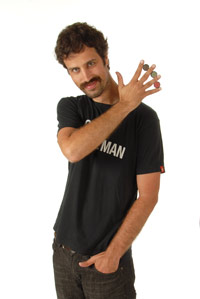

Interview with Eric Potma

IDEX Health & Science: You have been conducting research using coherent Raman scattering (CRS) microscopy for several years now. What inspired you to become involved in this field of microscopy?
Eric Potma: As a graduate student in the late 1990’s, I was working on implementing several nonlinear spectroscopy techniques in an optical microscope. We had a great dual color ultrafast laser light source and, inspired by the two-photon excited fluorescence technique, we were planning to explore various types of optical nonlinearities in the focal spot of a high numerical aperture lens. Initially, we were working on two-color pump-probe type of techniques. We jumped on the coherent anti-Stokes Raman scattering (CARS) technique right after I heard of the nice CARS implementation by Prof. Sunney Xie and co-workers in 1999. The CARS technique requires two laser beams of different color, which is exactly what we had on our optical table. It was thus relatively easy to convert our microscope into a CARS microscope. It took only a day or so. I was immediately taken by the elegance of the technique, and by its ability to map out biological samples free of fluorescent labels. Despite its potential, however, the CARS microscope was not ready for prime time in 1999. Lots of work needed to be done to improve the capabilities of the technique in terms of imaging speed and contrast, and so I decided to spend the years thereafter on contributing to getting CARS up to speed and to demonstrate its use in biological imaging. More than ten years later, I am still fascinated by the technique.
IDEX Health & Science: First there was coherent anti-Stokes Raman scattering (CARS) microscopy. Recent efforts have lead to the development of stimulated Raman scattering (SRS) microscopy. Which microscopy technique should one choose and why?
Eric Potma: The great advance made by coherent Raman techniques in general is the ability to generate images with molecular specific contrast at acquisition rates that are on par with the fastest fluorescence microscopes. With such imaging capabilities, it is possible to examine distributions of molecules in live tissues in real time without the use of labels, a feat that was previously unthinkable. For instance, CARS has made it possible to visualize lipid distributions in live tissue at video rate. CARS microscopy has been used extensively for imaging of lipids, with great success. Naturally, every technique has its advantages and disadvantages. CARS microscopy is less suitable for detecting molecules present at relatively low concentrations, whereas stimulated Raman scattering (SRS) is more sensitive to a wider variety of molecules, even at low concentrations. For instance, SRS microscopy can be used to track pharmaceuticals that are topically applied to the skin, which remains a challenge for CARS. On the other hand, SRS is not trivial to implement for rapid imaging of live tissues, which is relatively easy with CARS. I see both techniques as complementary rather than as competing technologies. Whether CARS or SRS is a better choice depends very much on the type of sample and imaging application.
IDEX Health & Science: In your current research you combine CARS microscopy with other nonlinear optical (NLO) imaging techniques, such as multiphoton fluorescence. Why is this?
Eric Potma: When the sample is illuminated with ultrafast laser pulses, several nonlinear processes occur simultaneously, producing a range of optical signals. Each of these signals tells a story about the properties of the sample, and can thus be used to paint a rich picture of the specimen. Multi-photon fluorescence, for instance, reveals the presence of endogenous fluorophores, such as elastin fibers or agents like nicotinamide adenine dinucleotide. Furthermore, second-harmonic generation detects collagen fibers, third-harmonic generation probes microscopic morphological information, and pump-probe signals are sensitive to chromophores like hemoglobin. In principle, all these signals can be collected simultaneously with the coherent Raman signal. In this multimodal approach, the sum is greater than its parts. So much new information can be gleaned from the co-localization of several molecular compounds, which often reveals hidden interactions or pathways that cannot be resolved with a single imaging modality.
IDEX Health & Science: Your research group has close ties with the Beckman Laser Institute & Medical Clinic at UC Irvine. How did this come about, and what is the motivation behind the collaboration?
Eric Potma: I believe that the fast imaging capabilities of coherent Raman imaging and other nonlinear techniques are ideally suited for examination of superficial tissues. It is, however, not straightforward to apply the technique to actual patients, which involves strict regulations and protocols. To optimize and test the imaging technique as a diagnostic tool, an infrastructure is needed where the translation from the optical lab to the clinical examination room can occur in a streamlined fashion. This is exactly the kind of environment that the Beckman Laser Institute (BLI) provides. I have an adjunct position in the BLI and I work directly with several researchers at the Institute, with the primary goal to help move nonlinear imaging technologies, such as CARS, into the clinic.
IDEX Health & Science: What does the future hold for multimodal NLO imaging, and are there any challenges that must be overcome?
Eric Potma: Multimodal NLO imaging techniques play an important role as a diagnostic tool for superficial tissue samples. In the future it will be possible to examine lesions present on skin and in body cavities. The latter will be facilitated by the development of small optical probes, which enable label-free, real-time recordings of the patient’s tissue. One of the biggest challenges is to improve the depth within the tissue at which NLO images can be taken. Currently, the imaging depth is 200 microns or less for most tissue types, which is often insufficient. To make NLO techniques clinically relevant, the limited imaging depth must be improved upon.
IDEX Health & Science: Can you share with us your plans and goals for future work in this area?
Eric Potma: My group is working on three different fronts. The first project focuses on translating NLO imaging into a medically relevant tool. The second project aims to utilize coherent Raman imaging and related techniques as a basic research tool for addressing a range of biological problems. These biological imaging studies typically do not require imaging patients or live animal models. For instance, we use CARS and SRS extensively to study cholesterol in ex vivo atherosclerotic lesions, to examine lipid composition in meibomian glands, and to measure water uptake by biological fibers. In a third project, we use nonlinear coherent microscopy to study non-biological samples, such as fabricated nano-structures, plasmonically active substrates and selected molecular compounds. Besides biological applications, the many NLO imaging techniques are a great help in material research.
IDEX Health & Science: Finally, what advice would you give to someone interested in pursuing a career in this specialized field?
The NLO imaging field and coherent Raman imaging in particular, is a discipline that continues to grow. The field has seen tremendous advances in the last decade. Because imaging is so crucial to the advancement of science in general I expect that this trend will continue in the future. It is a field that brings together people from the disciplines of engineering, physics, chemistry, biology and medicine, which makes it a very exciting area to work in. I can very much recommend a career in NLO imaging to anyone interested in pushing the boundary between what is currently visible and what remains hidden from view. Much of the microscopic world is still invisible to us. There is so much more waiting to be discovered.
